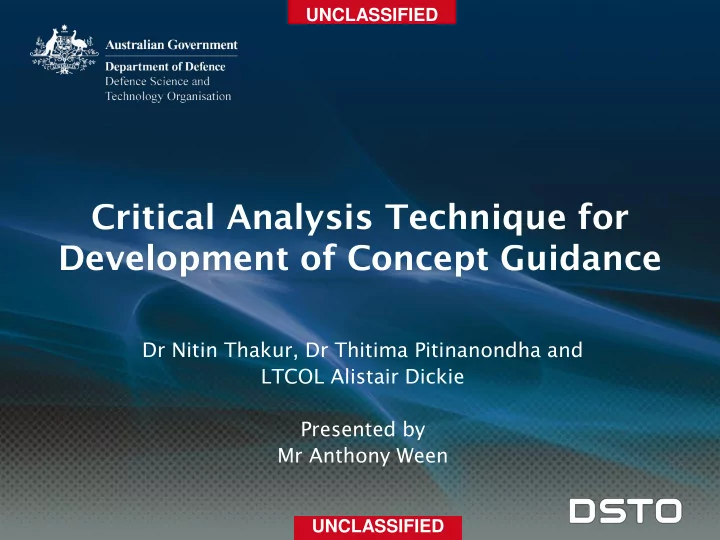

UNCLASSIFIED Critical Analysis Technique for Development of Concept Guidance Dr Nitin Thakur, Dr Thitima Pitinanondha and LTCOL Alistair Dickie Presented by Mr Anthony Ween UNCLASSIFIED
UNCLASSIFIED Presentation outline Introduction Concepts for Defence Planning Challenges in Concept Development Critical Analysis – Methodology Concept Guidance Development Potential Contribution UNCLASSIFIED
UNCLASSIFIED Introduction Strategic Military Planning Ends - establishment of military objectives • Ways - formulation of military strategic concepts to accomplish • the objectives Means - use of military resources to implement the concepts • Concepts Describe how to use current and approved capabilities (Force-in- • being) Inform capability development decisions for future capabilities • that are not yet approved (Future Force Posture) Concepts play a crucial role in Force Design as forerunners of capability goals (with attributes) • gaps and risks • inter-dependencies – for force design activities • UNCLASSIFIED
UNCLASSIFIED Concepts for Defence planning Joint Warfighting Functions, Future FJOC Strategic Response Options Environment Precepts Future Planned Force Capability statements, measurable Concepts for Future Operational Attributes Concepts Current / Endorsed CONOPS future Capabilities Employed Force Qualitative & quantitative system characteristics and requirements CONEMPS Requirement generation OCDs UNCLASSIFIED
UNCLASSIFIED Challenges in concept development Guidance currently provided by the capstone operating concept is too diffuse and strategic for use in specific operational contexts • for force structure and capability needs analysis • Future operational concepts need to have a direction provided, in terms of where systematic failures could occur and knowledge of critical sub-systems, so that the organisation is aware and prepared (with concepts) to address these criticalities. UNCLASSIFIED
UNCLASSIFIED Critical analysis methodology Failure Mode, Effects and Criticality Analysis (FMECA) methodology originally developed by the U.S. military (1949) and employed as an analytical technique for evaluating failures to determine the reliability of equipment and system. Three basic steps in conducting a FMECA: Determining the Probability of Occurrence (O) for each failure • mode of the product or system using a scale such as frequent, occasional, or extremely unlikely. Determining the Severity (S) of the failure mode of the product • or system in terms of potential consequences, using a scale such as catastrophic, critical, or marginal. This provides the Criticality assessment of that failure mode • which is the mathematical evaluation of the occurrence and severity: Criticality = (O) × (S). UNCLASSIFIED
UNCLASSIFIED Concept guidance development ‘Failure mode’ is adapted in this context as a Defence -relevant risk event that might eventuate, with a probability of occurrence (O). It is assumed, in this context, that the frequency of response from Defence to this risk event, achieved by using specific functions or tasks, indicates the severity (S) of this risk event. Criticality of that Defence function or task is then a product of likelihood- impact of the risk and the frequency of occurrence of the function or task. Using extant endorsed Defence artefacts DOEFs – Defence Operational and Enabler Functions – 18 Lines Of • Operations DPRs- Defence Preparedness Requirements – 8 High Level Tasks • SRAs- Strategic and Enterprise Risks • UNCLASSIFIED
UNCLASSIFIED Concept guidance development How often will each function be used as a main or supporting line of operation for each DPR-based task? UNCLASSIFIED
UNCLASSIFIED Concept guidance development How often would each task be used if a Strategic Risk event develops? Context DPR1 DPR2 DPR3 Basis Risk Event Likelihood Consequence Risk Frequency Criticality Frequency Criticality Frequency Criticality Potential Pandemic Unlikely Severe Moderate Often Harrassment Unlikely Major Low Often Regional Conflict Impossible Severe Low Always Critical Conventional Attack Impossible Severe Low Always Critical An ‘ Always ’ (from previous Derived from the Strategic slide) for Special Operations Risk Assessment drives the criticality UNCLASSIFIED
UNCLASSIFIED Concept guidance development Concern or criticality = Frequency of task x risk associated with that event Enduring Tasks for each Function + Criticality of Tasks in the Strategic Risk context = Criticality of Tasks required for each Function Develop the concept associated with a DOEF by answering - ‘ How ’ will the tasks that are critical to this concept/function be executed to achieve the strategic objectives? UNCLASSIFIED
UNCLASSIFIED Example As an example, a brief construct of the concept for Special Operations could look like: Central Idea for Special Operations : The Joint Force will conduct the Function of Special Operations through the collective effect of Task DPR2 which is crucial in the context of Conventional Attack and/or Regional Conflict (viz. Strategic Risks). Defining Capability Statements : Special Operations will achieve success by having the ability to infiltrate and exfiltrate from terrain previously untraversable. Attributes for Special Operations : Special Operations need to be fully integrated with function Joint Fires and Effects, with the measure as achieving a good degree of precision. UNCLASSIFIED
UNCLASSIFIED Potential contribution Higher level concepts have not been used in anger, nor are they embedded in the force design process, or articulated practically at the high level. Force design has used operational planners with current concepts for future force design, highlighting the lack of strategic planners with access to future concepts to test against future environments and strategic risks. Demonstrate that there are organisational artefacts that can be used to provide robust linkages for logical transparency, and that these linkages can lead to a healthy structured basis for decision audit. Showcases how concepts can be the forerunners of capability goals by forcing development of capability statements, risks, integration issues for lower layers of capability development and setting of requirements for acquisition. UNCLASSIFIED
UNCLASSIFIED Questions? UNCLASSIFIED
Recommend
More recommend